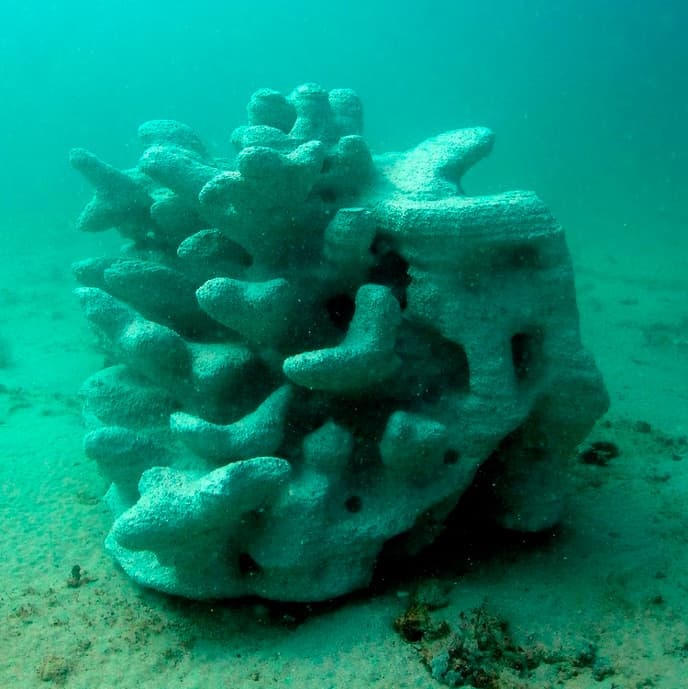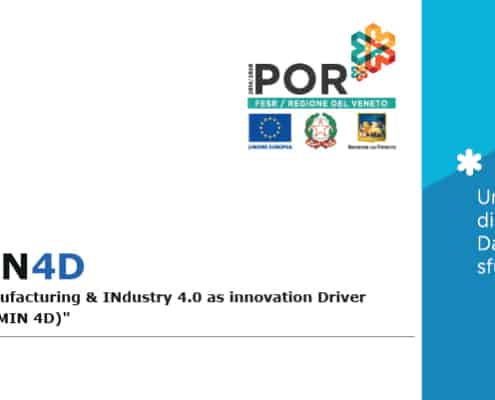3D PRINTED NATURAL REEF: AN INTRODUCTION TO THE PROBLEM AND INNOVATIVE SOLUTIONS
Coastal erosion, the gradual disappearance of local marine fauna and of the coral reefs that provide a natural barrier to waves and a habitat for the marina fauna, must be considered the dramatic consequences of both environmental changes and manmade pollution and damage. According to a 2003 study by Cesar Environmental Economics Consulting (CEEC) in the Netherlands, over 27% of the world’s coral reefs have already been lost. It was also estimated that 60% of the world’s coral reefs will be destroyed over the next 30 years at the present destruction rate. (Source: Cesar H, Burke L, Pet-Soede L. The economics of worldwide coral reef degradation. The Netherlands, International Coral Reef Action Network (ICRAN) and Cesar Environmental Economics Consulting (CEEC), 2003, you can read the research in pdf here).
According to the US National Oceanic and Atmospheric Administration (NOAA), healthy coral reefs have rough surfaces and complex structures that dissipate much of the force of incoming waves; this buffers shorelines from currents, waves, and storms, helping to prevent loss of life, property damage, and erosion Furthermore, of the $29.8 billion global net benefit of coral reefs, $9.0 billion is accounted for by the coastal protection coral reefs provide. In the US alone, coastal storms account for 71 percent of recent annual disaster losses. Each event costs roughly $500 million, and while not all of these events occur in areas that would naturally contain reefs, healthy reefs could reduce the cost in those regions that do. Each meter of reef protects an estimated $47,000 of property value. In Florida, the absence of coral reefs would cause parts of the state to be submerged. In Belize, coastal protection afforded by reefs and mangroves provide an estimated $231 to $347 million in avoided damages per year. By comparison, Belize’s gross domestic product in 2007 was $1.3 billion. (Source: NOAA).
As a response to this problem that is reaching catastrophic proportions, a number of agencies and groups worldwide are developing and implementing programs to 1) slow down and mitigate the causes of natural coral reef destruction and, 2) develop plans and strategies for the replacement of damaged and destroyed natural reefs through implementation of artificial reef placement. The US government approach was started through the The National Fishing Enhancement Act of 1985 which included the development of a long term National Artificial Reef Plan. Since then, a number of programs have been initiated at a federal, regional and state level to address and develop funding for artificial reefs.
Recently as response to the need for artificial reef technologies, Desamanera SRL in Italy felt the need to develop innovative solutions to these problems. Their interest was driven by a report by the Italian Ministry of the Environment that estimated that in Italy approximately 42% of the 4,000 kilometers of low-lying coastal areas (on a total of 7375 kilometers of coastline) is eroding and disappearing. Their approach has been to combine the freedom in the design of forms with the performance of 3D printed articles, taking nature as a model and incorporating environmental consciousness issue. While in the past potential solutions to the problem employed traditional approaches i.e. installation of precast concrete structures (often designed for other purposes), or by replacement of sand lost to erosion, the investment costs and negative effects on the environment have overshadowed any benefits obtained.
This is a broad issue that could be discussed in significant more detail from both a scientific and economic point of view that is beyond the scope of this posting. More detailed aspects will be discussed in future postings. Desamanera believes that large scale 3D printing has the potential to address effectively and economically the creation of artificial reefs taking nature’s model that are consistent with the environmental conditions and provide the basis for a natural recovery of the lost ecosystems.
3D Reefs for coastal protection
The coastal erosion problem stems from an alteration in the flow or supply of sand to the coastal areas due to natural (violent weather conditions, waves, winds and currents) or manmade effects (dredging, construction of dams, commercial and recreational navigation, coastal waste disposal, coastal overbuilding, etc.). It has been shown that the strategic placement of solid submerged structures can be very effective in mitigating erosion. Their optimal placement under the sea surface has the direct consequence of mitigating the effects of currents and tides in shallow areas, controlling the intake of sediment, waves, and mitigation of manmade currents. It is important to note that every local ecosystem behaves and responds differently. As a consequence, mitigation of erosion cannot be met in all areas of intervention with standard pre-assembled structures; each ecosystem needs specific elements that adapt perfectly to its morphology and take into consideration local natural (currents, tides, subsidence between these) and manmade processes. In general it has been shown that the introduction of submerged structures at a depth ranging from 1.5m to 2m can result in gains of up to 13 meters of beach in three years, consolidating the coastline and mitigating the swell. (Source: Rhinoceros Report).
The contribution in terms of innovation that large scale stone 3D printing can provide in this field is significant. The fact that utilizing 3D printing provides No limits in the production of freeform shapes means that thanks to 3D printing it is possible, after a preliminary study of the site and its environmental dynamics, to design and produce every reef with specific and the most appropriate features to stabilize a particular stretch of coastline. Only through the use of 3D printing can structures be designed to mimic the rough surfaces and complex structures that healthy coral reefs utilize to dissipate much of the force of incoming wave. Efficacy is not achieved with smooth structures with minimal complexity.
An analysis of the location with tools such as Google Earth, GPS and cameras (already tested and implemented in the US by Florida International University) can help the decision-making for optimal placement and design of the structure depending on the morphology of the area. Another tool such as Scan Sonar allow through its use to map large areas relatively quickly, returning detailed information on latitude and longitude, direction and degree of stability and durability of the reef.ra (Source: Boskalis).
Utilization of 3D printed artificial reefs to protect the coastline can provide the following benefits, as shown in recent implementations:
- Reduction of the need for expensive beach replacement. Beach replacement is significantly less durable than the creation of artificial reefs requiring periodical refurbishment. In addition, beach replacement can result in the burial of natural marine life in the shallow areas, with serious consequences to the ecosystem.
- Protection for the beach and its coastal infrastructure from the swell. Large submerged structures with holes and crevices of various sizes that do not hinder the normal flow of water also provide protection in the occasions of violent storms. In fact, these phenomena frequently erode sand from the coastline and, in the worst cases, cause significant damage to buildings and infrastructure built near the waterfront.
- Integrate the natural dynamics of the ecosystem, supporting and not hampering them. Standard approaches on the waterfront such as vegetation wood fences or breakwaters can make the coastline unsightly, permanently inaccessible, and result in imbalances of the ecosystem that are noxious or unhealthy.
- Enrichment of the habitat making it more prolific and welcoming to the local marine flora and fauna species, thus improving local leisure and recreational activities.
- Provide a flexible, economical solution that can be locally based and implemented.
3D printed reef photo gallery
The six reefs immersed in the Larvotto Reserve in Monaco
Published on 31st January 2016











